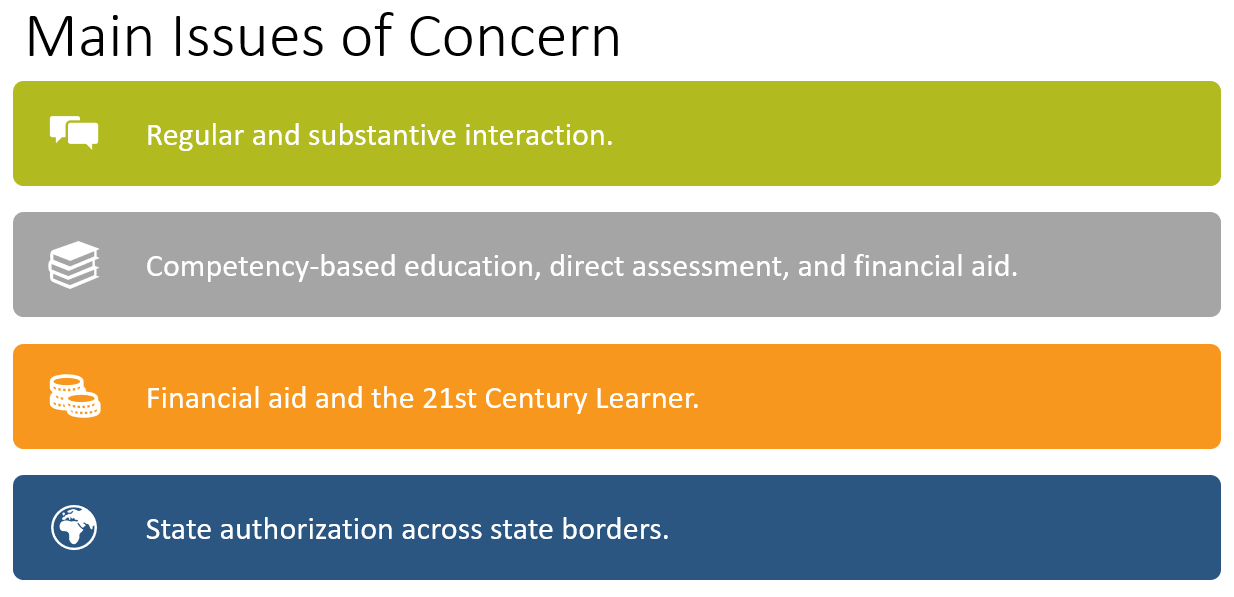The U.S. Department of Education begins meetings of its negotiated rulemaking main committee and subcommittees next week. There are several issues that will have an impact on the technology-enhanced higher education community. These decision will affect your students, faculty, and your operations.In this post we suggest some principles to use in developing regulatory language around a few select issues.
Lists of who will serve on the rulemaking committees and the initial recommendations for changes to regulations are supposed to be released later today on the Department’s negotiated rulemaking web page. They also should soon release links where you can watch the negotiations in live stream. WCET will continue to keep you updated on the progress of these negotiations.
– Russ Poulin, WCET
Principles for Addressing Educational Innovations in the
U.S. Department of Education’s 2019 Negotiated Rulemaking
A WORKING DOCUMENT
Introduction
Statutes and regulations implemented by Congress and the U.S. Department of Education seek to protect students along their postsecondary journey and assure that taxpayer funds are spent appropriately in supporting those students. Those goals, rightfully, remain paramount in federal oversight. However, some requirements placed on institutions may impede the development of new educational innovations and modalities that can better meet the needs of a changing postsecondary population.

To address this need for updating federal regulatory language around existing requirements, the U.S. Department of Education has committed to seeking “innovations in educational delivery that can reduce cost and better prepare students for the demands of contemporary work and life. “ In December 2017, the Secretary convened interested stakeholders to share their views on “Rethinking Higher Education,” and in October 2018, this led to the call for a negotiated rulemaking panel to convene early in 2018 to address a wide-ranging set of issues on “accreditation and innovation” among several other topics.
Due to the large number of issues under consideration, a subcommittee focused on “distance learning and educational innovations” has been named to support the panel’s work which will focus on “the ability of institutions to develop, and students to progress through, innovative programs responsive to student, employer, and societal needs. This subcommittee could consider revisions to regulations that are barriers to implementation of such programs, including certain requirements for term based academic calendars and satisfactory academic progress.”
This important work cannot be completed in a vacuum, however, and requires the active involvement and expertise of all stakeholders in educational innovations. To help facilitate that involvement, WCET (the WICHE Cooperative for Educational Technologies) reached out to leaders of other organizations in this field and invited their input on several significant regulatory challenges. We also sought input from WICHE leadership. While this paper focuses on the upcoming negotiated rulemaking session, we understand that full implementation of some changes may be beyond the scope of rulemaking and may require action by Congress.
We appreciate the input and have used it to create a “working document” as a first step in informing the upcoming negotiated rulemaking work. We anticipate the release of a series of in-depth position papers that will provide more analysis of the issues raised in this preliminary document.
As a result of our own work and the advice of colleagues, we decided that we should:
- Focus on a Few Issues. The issues to be considered in the proposed rulemaking are complex and controversial. This paper focuses on four of the issues that fit the concerns and expertise of our membership:
- Regular and substantive interaction.
- Competency-based education, direct assessment, and financial aid.
- Financial aid and the 21st Century Learner.
- State authorization across state borders.
- Provide a Brief History. The rulemaking panel will have a variety of expertise and many issues to consider. A concise history (with citations) will provide the context to understand challenges of addressing the issue in the past and to avoid potholes encountered in resolving the issue. It will also provide a guide for further investigation of particular concerns.
- Suggest Principles. A set of “principles” are handy in guiding the rulemaking panel along the path to determining the exact language to meet the needs of the students to be served by educational innovations.
This “working document” seeks to inform the initial discussions in the rulemaking process. We encourage our colleagues to build on this platform and anticipate that subsequent versions, additions, and revisions will likely emerge for committee consideration.
Issues of Concern

Regular and substantive interaction
The statutory and regulatory definitions of distance education state, in part, that it must “support regular and substantive interaction between the students and the instructor, synchronously or asynchronously” (Higher Education Opportunity Act, Pub.L. 110-315, 122 Stat. 3078, codified as amended at 34 C.F.R. §600.2). However, the meaning of the term regular and substantive interaction has never been clearly defined in either statute or by the U.S. Department of Education. As such, institutions offering distance education are held to a standard that impacts financial aid eligibility that remains ill-defined by the Department of Education and Congress. The result is confusion in how institutions are to comply and barriers to the creation of innovative programs that are effective in serving student needs.
Competency-based education, direct assessment, and financial aid
The Higher Education Reconciliation Act of 2005 recognized direct assessment programs as an alternative path to Title IV financial aid eligibility for students in programs approved by the U.S. Department of Education. This action was meant to open up financial aid eligibility to students enrolled in competency-based education and other programs that are not tied to the credit hour or the traditional academic year. However, very few direct assessment programs have been approved as competency-based education programs continue to struggle with balancing innovation and regulatory compliance. Some of those biggest challenges stem from regulations that still focus on semester credit hours, traditional definitions of the academic year, and satisfactory academic progress. The result is confusion in how institutions are to comply and a potentially chilling effect on the growth of competency-based education programs.
Financial aid the 21st Century Learner
Even though higher education and the students we serve have drastically changed since the passage of the original 1965 Higher Education Act, the reward and disbursement of financial aid has changed very little. The combination of older students, new types of credentials, innovative delivery methods, new types of providers, and the need for students to gain new skills through their working lives is now out of step with the current federal financial aid system. In order to provide access to the largest number of students, new regulations and types of financial aid should be considered, including the continuation of year-round Pell, increasing aid to part-time students, using aid for short-term credential programs, and allowing students to access Title IV aid for post-baccalaureate programs. The result of financial aid policies tied to traditional calendars and credentialing is limitations on access to programs that help students obtain skills needed in the workforce.
State authorization across state borders
States have always had the ability to regulate institutions conducting instruction other postsecondary activities in their states. In Fall 2010, a Federal regulation was first released tying institutional and student eligibility for Title IV Federal Financial aid to an institution complying with State laws. This regulation, 34 C.F.R . §600.9(c), was vacated in 2012 by the Federal courts on procedural grounds. Since that time, attempts to re-establish the regulation have met difficulty reaching a final effective solution. In 2014, a rulemaking panel failed to reach consensus on a proposed rule. A subsequent rule, released by the Department of Education in 2016, has since been delayed and sent back to rulemaking. The result is confusion in how to comply and some institutions have taken the necessary consumer protection steps to meet existing state and federal regulations.
History of Regulatory Guidance
Please see the appendix for a timeline with highlights of the legislation and regulatory guidance associated with the four issues of concern.
Regulatory Goals and Guiding Principles
Regulatory goals
Changes and improvements to federal financial aid regulations proposed by the Negotiated Rulemaking Committee should meet all three of the following overarching goals:
- Protect students. Many students have only one chance at pursuing postsecondary and they need to make the most of that investment of time and money. Students need protection from those who are more interested in money than in education. Students need clear and truthful information to make informed choices.
- Combat fraud. Implement guardrails that protect students for unscrupulous education providers but are not so onerous as to deny students viable educational options.
- Foster innovation. Create pathways for educational innovations to be tested, improved, and, if warranted, ultimately mainstreamed.
Guiding principles

- Fairness to all students.
- Provide aid to students wherever they are in their educational journey with attention to students of all ages and attending any time during the year. (21st Century Learner)
- Provide aid to students using a variety of educational modalities (e.g., distance learning, CBE) that meet their needs. (Competency-based Education (CBE))
- Provide aid to students using a wider variety of educational programs, including shorter-term credential programs. (21st Century Learner)
- Incentivize, don’t punish, institutions for being innovative.
- Create clear regulations for non-traditional academic programs, such as non-credit hour programs, short-term credential programs, and programs that use adaptive technology and other alternative instructional models (Regular and Substantive Interaction (RSI), CBE)
- Expand the use of the Department’s experimental site authority to identify emerging promising practices in nontraditional programs. Not only would such an expansion allow institutions to create innovative programs that could expand educational access, but it would also place appropriate guardrails around the development of such programs by requiring institutions to balance improved outcomes with protection of various student populations. (21st Century Learner)
- Treat all modalities the same. Do not hold non-face-to-face modalities to a different set of standards. (21st Century Learner)
- Transform quality assurance standards to rely on educational outcomes.
- Change from input measures (i.e., what activities occur in a class) to output measures (i.e., performance scores, evidence of academic activity). (RSI)
- Develop transparent outcomes measures to empower faculty and administrators to clearly understand the steps to be taken to be in compliance. (RSI)
- Align quality assurance standards with those used by accrediting agencies. (RSI, CBE)
- Simplify regulations around financial aid program eligibility requirements.
- Current requirements that CBE and direct assessment programs map back to credit hours can be time consuming, expensive, and, sometimes, contradictory. (CBE)
- The Department should consider developing new standards that would be alternatives to credit hours, such as standardizing the definition of a competency and clarifying the relationship between competencies and credit hours. (CBE)
- Treat all educational modalities the same. Do not hold non-face-to-face modalities to a different set of standards. (21st Century Learner, CBE)
- Support interstate reciprocity agreements as a recognized means for state approval of institutions. (State Authorization)
- Protect student and federal financial aid investments.
- Make federal financial aid contingent on states approving (either directly or through reciprocity agreements) institutions serving students who are located in their state. (State Authorization)
- Expand the Department’s experimental site authority into a multi-step process that protects students while enabling educational innovations. Not only would such an expansion allow institutions to create innovative programs that could expand educational access, but it would also place appropriate guardrails around the development of such programs by requiring institutions to balance improved outcomes with protection of various student populations. (21st Century Learner)

Van Davis
Principal
Foghlam Consulting, LLC
WCET Steering Committee Member

Cheryl Dowd
Director
WCET State Authorization Network

Daniel Silverman
Assistant Director
WCET State Authorization Network

Russ Poulin
Senior Director – Policy, Analysis, & Strategic Alliances
WCET
Appendix
A Timeline of Legislation and Regulatory Guidance
- 1992
- Higher Education Act Amendments of 1992
- Creation of the 50% rule which disallowed financial aid eligibility for institutions where either more than 50% of the courses are offered via distance learning or more than 50% of students were enrolled in distance education.
- The amendments also:
- Defined an academic year as 30 weeks of instruction with 12 hours of instruction occurring each week (12-hour rule).
- Defined a full-time student as one who completed 24 semester credit hours.
- 1998
- Higher Education Act Amendments of 1998
- Created the Distance Education Demonstration Program which provided the Department of Education the authority to waive portions of financial aid regulations related to Title IV financial aid.
- 2002
- The 12-hour rule is repealed. An academic year is defined as 30 weeks of instruction where each week contains one day of instruction.
- 2004
- The Government Accountability Office, responding to the increase in distance education reports on the possibility of financial aid fraud and distance education.
- 2006
- Higher Education Reauthorization Act of 2005 (final passage in 2006)
- 50% rule is rescinded and Title IV financial aid eligibility is extended to distance education programs.
- Direct assessment, programs that do not rely on semester credit hours, become eligible for Title IV financial aid.
- 2008
- Higher Education Opportunity Act
- Removed the definition of a telecommunications course.
- Made explicit the difference between correspondence education and distance education.
- 2010
- The Department of Education’s Office of Inspector General issues an audit of the Higher Learning Commission faulting the accreditor for not “establish[ing] the definition of a credit hour or set minimum requirements for program length and the assignment of credit hours.”
- The Department of Education issues a number of rules relating to Program Integrity, including rules which define a semester credit hour and link institutional financial aid eligibility with an institution’s compliance with state regulations in all states where distance education students might reside.
- 2011
- The Department of Education issues a Dear Colleague Letter outlining the regulations associated with the new semester credit hour rules.
- The Office of Inspector General releases a report outlining concerns over financial aid fraud and distance education.
- The Department of Education issues regulations on student identification in distance education in an effort to curtail any financial aid fraud.
- The Association of Private Sector Colleges and Universities sues the Department of Education over the release of regulations linking financial aid eligibility to authorization in every state in which distance education students reside. The United States District Court for the District of Columbia rules that the Department did not follow its own procedures and vacates the regulations because on procedural grounds.
- In an effort to streamline the approval process for institutions serving students in other states, the National Council for State Authorization Reciprocity Agreements (NC-SARA) is created.
- 2012
- The 2nd Circuit Court of Appeals upholds the 2011 ruling vacating distance education state authorization rules.
- The Department of Education’s Office of Inspector General releases an audit of Saint-Mary-of-the-Wood College finding that the institutions distance education programs are ineligible for federal financial aid because they do not contain “regular and substantive interaction” between instructors and students.
- 2013
- The Department of Education issues a Dear Colleague Letter outlining the approval process and requirements for institutions offering direct assessment programs to receive federal financial aid.
- 2014
- The Department of Education issues a Dear Colleague Letter outlining the regulations regarding direct assessment, competency-based education, and regular and substantive interactions.
- The Department of Education’s Office of Inspector General issues an audit faulting the Department of Education’s financial aid division for insufficiently reviewing institutions offering direct assessment that wish to receive federal financial aid.
- The Department of Education launches a negotiated rulemaking process to create new regulations on distance education state authorization.
- 2015
- The Department of Education’s Office of Inspector General issues an audit of the OIG audit of the Higher Learning Commission finding that the accreditor was not sufficiently reviewing direct assessment programs.
- The Department of Education exercises its Experimental Sites authority and calls for institutional proposals from schools offering competency-based education and direct assessment that wish to have certain financial aid regulatory requirements waived.
- 2016
- The Department of Education’s Office of Inspector General releases an audit of the Western Association of Schools and Colleges where it faults the accreditor for insufficiently reviewing competency-based education and direct assessment programs.
- After a failed negotiated rulemaking process, the Department of Education issues new rules related to state authorization and distance education that are slated to go into effect in 2018.
- The Department of Education selects eight schools for participation in its Educational Quality through Innovative Partnerships (EQUIP) program designed to test financial aid eligibility for programs offered by non-traditional providers.
- 2017
- The Department of Education’s Office of Inspector General issues an audit of Western Governors University that finds the institution in violation of regular and substantive interaction regulations and ineligible for federal financial aid.
- 2018
- The Department of Education delays the implementation of the 2016 distance education state authorization rules.
- The Department of Education issues a call for nominations for a 2019 negotiated rulemaking committee to address a number of issues including:
- State authorization of distance education regulations.
- Competency-based education, direct assessment, and financial aid eligibility
- The role of accreditors and accreditation.
- Financial aid eligibility for non-traditional programs and providers.
- Regular and substantive interaction and other regulations that impact distance education.









2 replies on “ED Negotiated Rulemaking: Suggested Principles for Addressing Issues”
[…] View Original Source […]
[…] January 6th, WCET published Principles for Addressing Educational Innovations in the U.S. Department of Education’s 2019 Negot…. This document outlined four areas of concern and five guiding principles that WCET in […]